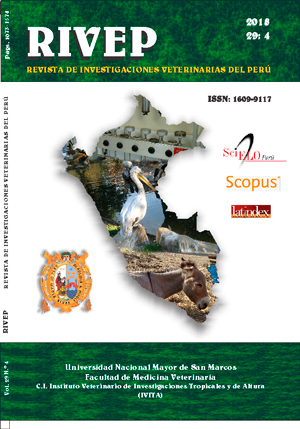In vitro maturation of Brycon henni eggs (Pisces: Characidae) with two hormonal preparations
DOI:
https://doi.org/10.15381/rivep.v29i4.15186Keywords:
hormones, in vitro maturation, fishes, reproductionAbstract
The ‘sabaleta’ (Brycon henni) is a species of commercial interest in Colombia. One of the main barriers to the conservation processes of this species is the temporal asynchrony between the reproductive cycles of females and males, which could be solved using biotechnological processes. The aim of this investigation was to evaluate the in vitro maturation of ‘sabaleta’eggs (Brycon henni) using two hormonal preparations. A total of 1200 eggs were subjected to in vitro maturation in the presence of carp pituitary extract (EPC), salmon gonadotropin-releasing hormone (sGnRHa) and a control without hormonal stimulation. The eggs were incubated for 2 hours at 25 °C in constant orbital shaking and 80% O2. The in vitro maturation of the eggs was evaluated by classifying the position of the nucleus in four categories: migratory, central, atretic and peripheral. Higher maturation advancement were obtained due to the presence of migratory nucleus (p<0.05) for EPC (46.0 ± 8.4%) and sGnRHa (40.0 ± 13.3%), compared to the control (24.0 ± 9.6%). It is concluded that the use of EPC and sGnRHa hormonal preparations during in vitro maturation promotes the advancement of maturation of ‘sabaleta’ eggs (Brycon henni).Downloads
Downloads
Published
Issue
Section
License
Copyright (c) 2018 Juan David Montoya Páez, Hermes Pineda Santis, Giovanni Restrepo-Betancur

This work is licensed under a Creative Commons Attribution-NonCommercial-ShareAlike 4.0 International License.
AUTHORS RETAIN THEIR RIGHTS:
a. Authors retain their trade mark rights and patent, and also on any process or procedure described in the article.
b. Authors retain their right to share, copy, distribute, perform and publicly communicate their article (eg, to place their article in an institutional repository or publish it in a book), with an acknowledgment of its initial publication in the Revista de Investigaciones Veterinarias del Perú (RIVEP).
c. Authors retain theirs right to make a subsequent publication of their work, to use the article or any part thereof (eg a compilation of his papers, lecture notes, thesis, or a book), always indicating the source of publication (the originator of the work, journal, volume, number and date).










